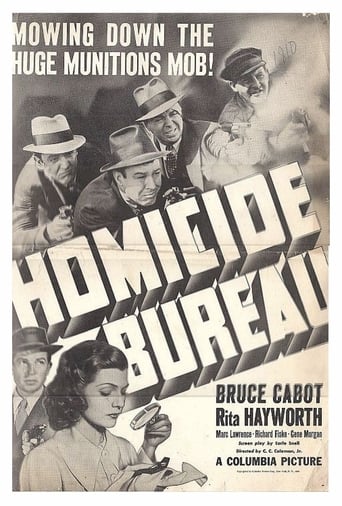Michael O'Keefe
Police Captain Haines(Moroni Olsen)is fed up with the public's lack of approval on the way a crime epidemic is being handled. He orders his men to clear up their investigations without violating the constitutional rights of the arrested criminals. This will please the newly appointed head of the Police Department Lab and internal affairs. Detective Jim Logan(Bruce Cabot)is of the old school opinion...a little pushing and thumping is OK in making an arrest. Haines is forced to demote him, but Logan doesn't really care. He discovers that some local junk dealers are enabling crime bosses in the accumulation of scrap metal to send to foreign powers(not clearly identified) to manufacture munitions in aiding their war efforts.After this movie, Miss Hayworth will be on her way to major stardom. At times Cabot seems one-dimensional and pedestrian to the script. Other players include: Marc Lawrence, Norman Willis, Richard Fiske and Stanley Andrews.
tedg
With the US just about to enter the war, Hollywood started to bend toward the mission. This is a rather interesting and peculiar case.Its an ordinary police procedural, with a tough cop, someone who yearns for what in movieland was "the good old days" when he could just beat crooks up. But the world is different now, presumably because the characters have to rise to the moral challenge. That's the first striking change we see.But there are two others, and the way they are spliced in makes it easy to imagine the script planning discussions.Early in the war, planners thought it would be short and determined by the ability to manufacture things fast. Since the pipeline for steel was longer than they thought the war would last, and had other problems, the idea was to call in the nation's scrap. So this plot has evil profiteers diverting scrap to enemies. This plot point is screwed a bit when we learn there is more deadly cargo included, but I suppose they thought it sufficient to just mention scrap and its importance.The other change is the movement of women into men's jobs. In this story there's a completely inessential line about Rita Hayworth taking over the job of chief forensic scientist and proving her mettle. Naturally, she still is a romantic interest who gets won by the tough cop.Ted's Evaluation -- 1 of 3: You can find something better to do with this part of your life.
HarlowMGM
HOMICIDE BUREAU is a nifty little police "B" melodrama from 1939 of interest mainly for the very beautiful (and very young, age 20) Rita Hayworth in the female lead as a forensics expert who replaces a police department's veteran (aged 60 and forced into mandatory retirement!). Across town, ex-felon Marc Lawrence trails a man into a pool hall and shoots him down in the presumably empty hall. The bartender happens onto the scene and (in an astonishingly incredible scene) the ex-con (gun still in his hand) is startled and darts away - the bartender then spots the murder victim's gun (he had been beaten to the draw) picks it up and chases out into the street where he spots the murderer driving away and then begins to shoot up his car but the man gets away. He is later able to identify the man but the man insists he has gone straight and is now a junk dealer and when his gang members replace the windshield with a new, broken windshield and plant a gun in the car that was not the murder weapon, he is released much to "copper" Bruce Cabot's disgust. The man is in fact in the salvage business - but is part of a ring that is selling black market scrap metal to foreign countries to make munitions. There are two more murders, close calls for several cops including the chief, and lots of action before a predictable finale in this 58-minute little pistol with a hard-line "once a crook, always a crook" mentality.Rita is absolutely gorgeous and to her credit, does suggest a woman with the intellect to handle her position although her role is quite secondary. I've never been particularly impressed with Bruce Cabot before but he is sensational here as a cop so hard he makes many more famous film noir tough-guy movie policemen seem like milquetoast. Marc Lawrence is very good too but the movie is stolen by Norman Willis as the gang leader. Willis, looking like a tougher Ricardo Cortez and sounding like a scarier Edward G. Robinson, played a ton of henchmen in films during this era (usually in small roles) but I don't think he ever had such a major menacing role to rival his gang leader/businessman here. I'm not quite sure who Richard Fiske plays in this movie, a cop or a crook, his role is quite small despite his billing, but he later became a real-life WWII hero, dying in action in 1944. This Columbia "B" may be long forgotten but it's a remarkably successful venture into Warner Bros. mean streets territory.
orlabrown
One thing that surprised me in this film was the amount of scientific documentation it exhibits. A female scientist is assigned to the police department in a forensics position. I was also surprised at how little controversy was shown about that fact. But during the course of the movie, comparison of materials (from a single source or not), ballistics evidence, weapon edge evidence and more are all showcased. Not quite a commercial for police as scientific marvels, seeing as how another part of the main story involves whether or not police ought to be able to rough up criminals or not, but considering how far before the Miranda ruling this movie was made, it now comes across as an interesting look at the state of forensics in the late 1930s. For true devotees of The New Detectives (and maybe CSI, though it has little to do with crime scenes per se), this is certainly an interesting title.


